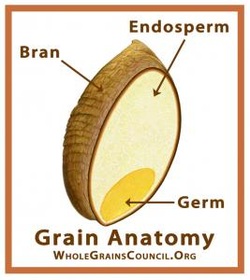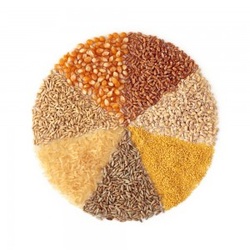
You hear about how whole grains are better for you all the time, and you feel good when you buy that whole grain bread, pasta, or wrap. But how do you know that what you’re buying really is whole grain?
To answer that, let’s start with what makes a whole grain whole. A whole grain is the entire grain seed which contains all the essential parts along with the naturally-occurring nutrients, including the fiber. There are three key parts to the seed (also known as the kernel): the bran, the germ, and the endosperm. The bran is the protective shell, and is high in fiber and B vitamins. This is what gives whole grain foods their gritty, nutty texture. The germ is the seed for a new plant, and contains B vitamins, protein, minerals, and healthy oils. The endosperm is the starchy interior with protein and some vitamins and minerals. All of the fiber and most of the nutrients in whole grains are found in the bran and the germ.
To answer that, let’s start with what makes a whole grain whole. A whole grain is the entire grain seed which contains all the essential parts along with the naturally-occurring nutrients, including the fiber. There are three key parts to the seed (also known as the kernel): the bran, the germ, and the endosperm. The bran is the protective shell, and is high in fiber and B vitamins. This is what gives whole grain foods their gritty, nutty texture. The germ is the seed for a new plant, and contains B vitamins, protein, minerals, and healthy oils. The endosperm is the starchy interior with protein and some vitamins and minerals. All of the fiber and most of the nutrients in whole grains are found in the bran and the germ.

Examples of whole grains include whole wheat, barley, brown rice, colored rices, wild rice, buckwheat, whole corn (including popcorn!), oats, whole rye, amaranth, millet, quinoa, sorghum, and triticale. Except for wheat, barley, and rye, all other whole grains are gluten-free. So there are many gluten-free whole grain options for anyone avoiding gluten.
Whole grains can remain whole or be cracked, split, flaked, or ground, and can be milled into flours and used to make breads, cereals, pasta, crackers, and other grain-based foods. Any "whole grain" food product must deliver approximately the same relative proportions of bran, germ, and endosperm found in the original grain in order to be considered whole grain. Another way to look at it is that a whole grain food product must deliver roughly the same amount of nutrients as the whole grain itself.
In order for breads, pastas, & so forth to be considered whole grain, 100% whole grain must be listed as the first ingredient, meaning that it is the most abundant ingredient and makes up at least 50% of the product. If 100% whole grain is not listed as the first ingredient (even if it’s the second ingredient), it can comprise up to 49% of the product at the most (less than half), and as little as only 1% of the product.
White flour is not a whole grain flour because the bran and the germ, which contain most of the nutrients and all of the fiber, have been separated and removed from the flour and therefore do not contain the same amount of nutrients as in the whole grain. Enriched whole grain flour is also not whole grain. Enriched tells you that the naturally-occurring nutrients have been removed, and the product has been enriched with synthetic versions of only some of the nutrients that were removed (because there’s no way to put all the original nutrients back in). You want to see 100% whole grain listed as the first ingredient to be sure you’re truly getting a whole grain product, no matter what it says on the front of the package. And don’t be fooled by a darker color, as some companies add coloring to give their product that whole grain look if they don’t contain much whole grain.
So to assure that you are getting a whole grain product, be sure to read the ingredient list and look for 100% whole grain (or 100% whole wheat, etc.) to be the first ingredient!
If you found “Whole Grains 101” helpful, please like this post and share it with your friends!
Whole grains can remain whole or be cracked, split, flaked, or ground, and can be milled into flours and used to make breads, cereals, pasta, crackers, and other grain-based foods. Any "whole grain" food product must deliver approximately the same relative proportions of bran, germ, and endosperm found in the original grain in order to be considered whole grain. Another way to look at it is that a whole grain food product must deliver roughly the same amount of nutrients as the whole grain itself.
In order for breads, pastas, & so forth to be considered whole grain, 100% whole grain must be listed as the first ingredient, meaning that it is the most abundant ingredient and makes up at least 50% of the product. If 100% whole grain is not listed as the first ingredient (even if it’s the second ingredient), it can comprise up to 49% of the product at the most (less than half), and as little as only 1% of the product.
White flour is not a whole grain flour because the bran and the germ, which contain most of the nutrients and all of the fiber, have been separated and removed from the flour and therefore do not contain the same amount of nutrients as in the whole grain. Enriched whole grain flour is also not whole grain. Enriched tells you that the naturally-occurring nutrients have been removed, and the product has been enriched with synthetic versions of only some of the nutrients that were removed (because there’s no way to put all the original nutrients back in). You want to see 100% whole grain listed as the first ingredient to be sure you’re truly getting a whole grain product, no matter what it says on the front of the package. And don’t be fooled by a darker color, as some companies add coloring to give their product that whole grain look if they don’t contain much whole grain.
So to assure that you are getting a whole grain product, be sure to read the ingredient list and look for 100% whole grain (or 100% whole wheat, etc.) to be the first ingredient!
If you found “Whole Grains 101” helpful, please like this post and share it with your friends!



 RSS Feed
RSS Feed